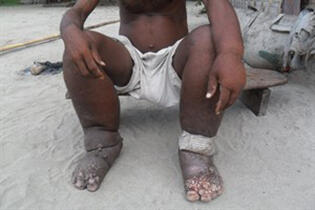
Successful global elimination of lymphatic filariasis, commonly known as elephantiasis, a debilitating infectious tropical disease, could hinge upon the addition of insecticide-treated bed nets to the current mass drug administration strategy. An international research team from LSTM and Case Western Reserve University, found that bed nets reduced infection transmission to undetectable levels, without the allocation of additional medication.
The study is published in the New England Journal of Medicine, on 22nd August 2013.
The study is authored by Dr Lisa Reimer, LSTM Lecturer, Mr. Edward Thomsen, LSTM Technical Research Officer and Professor James Kazura, Director of the Center for Global Health and Diseases at Case Western Reserve University School of Medicine. Co-authors include Professor Moses Bockarie, Director of the Centre for Neglected Tropical Diseases, at LSTM. This is a follow-up study of research, originally published by Bockarie and Kazura in The New England Journal of Medicine in 2002 where he and colleagues evaluated the safety and efficacy of administered annual antifilarial drugs over five years to five Papua New Guinea villages.
A parasitic-worm infection spread by mosquitoes, lymphatic filariasis affects approximately 120 million people in Africa, Asia, the Pacific, and the Americas. The study’s low-cost recommendation compliments the World Health Assembly and World Health Organization’s goal of eradicating the disease by 2020 through the use of mass drug administration, which involves the distribution of medication to an entire population irrespective of disease status.
Research has shown that the mass drug strategy nearly eliminated the parasite from the human body but did not stop its transmission by the mosquito vector.
Insecticide-treated bed nets are already widely used in areas where lymphatic filariasis and malaria are both present. These bed nets work in several ways to reduce disease transmission by mosquitoes. First, they serve as a barrier to female mosquitoes getting a blood meal, a process that is essential for the adult insect to lay her eggs and produce offspring. Second, the insecticide works to reduce the life-span of the insect by half, preventing it from living long enough to allow the parasite to develop to a stage that is capable being transmitting to other humans.
“We should not rely solely on mass drug administration to eliminate lymphatic filariasis. By combining the existing strategy with vector control, we are more likely to reach elimination thresholds,” Lisa J. Reimer, PhD, said, first author on the paper and currently a Lecturer at the Liverpool School of Tropical Medicine. “Our findings clearly demonstrate this low-cost solution could complement the successes of the current elimination program while having a high pay-off for both filariasis and malaria control.”
While vector control is not currently part of the global eradication solution, the study finds coupling the mass drug administration strategy with bed net distribution in malaria-endemic areas will protect the same individuals from lymphatic filariasis. Multiple bed net programs distribute the vector control tool for free across Papua New Guinea, the South Pacific and Sub-Saharan Africa.
The next several years will be important as Kazura and his colleagues in Papua New Guinea study the progress in eliminating the disease. The group will also be testing new drug combinations for mass treatment in nearby populations and evaluating the effects of broader bed net distribution in the country. The authors of the study include collaborators from Papua New Guinea Institute of Medical Research, Papua New Guinea Department of Health, Liverpool School of Tropical Medicine, University of Queensland, University of Notre Dame and Case Western Reserve University School of Medicine.
This research was funded by National Institutes of Health.